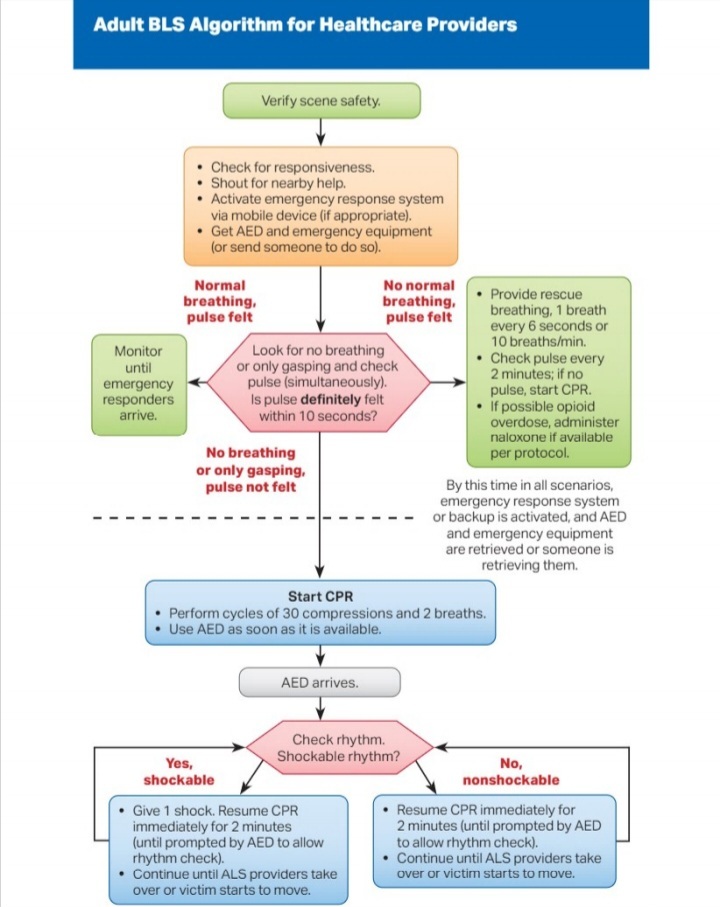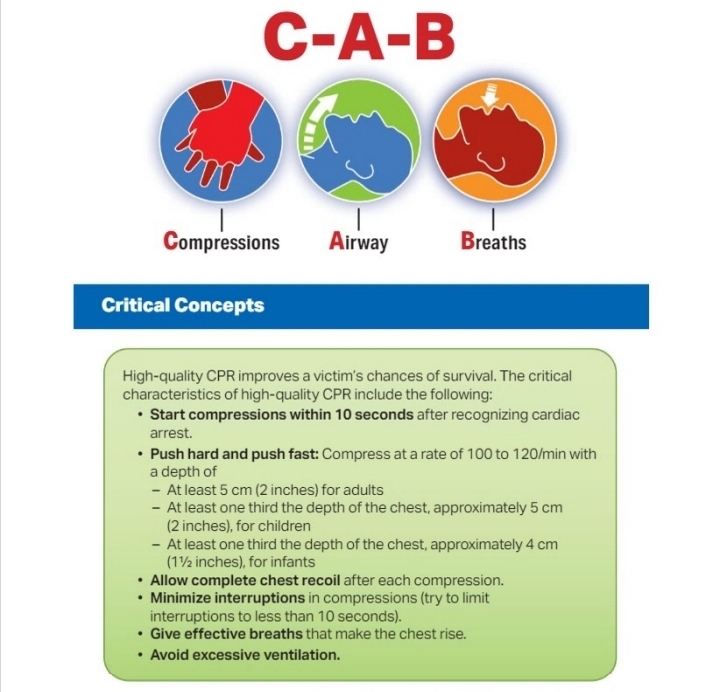(Images can be enlarged if needed)

Cardiac arrest, also known as Sudden Cardiac Arrest, is when the heart stops beating suddenly. The lack of blood flow to the brain and other organs can cause a person to lose consciousness, become disabled or die if not treated immediately.
The terms ‘heart attack’ and ‘cardiac arrest’ are often used interchangeably, but these are two different heart conditions.
A heart attack occurs when there is a blockage in the arteries that stops blood flow in the heart. Due to the lack of blood and oxygen flowing in the heart, the heart muscle tissue will become damaged. Heart attacks can increase the risk for cardiac arrest because heart attacks can alter electrical signals in the heart.
CPR – or Cardiopulmonary Resuscitation – is an emergency lifesaving procedure performed when the heart stops beating. Immediate CPR can double or triple chances of survival after cardiac arrest.
If someone experiences cardiac arrest, they need immediate treatment to increase the flow of oxygen-rich blood to their organs. CPR is the compression over the chest to manually pump a patients heart. Rescue breaths are preformed to provide oxygen to the body.
During CPR, proper hand placement on the lower half of the sternum is crucial. Placing hands over the sternum ensures effective chest compressions directly above the heart, optimizing blood circulation throughout the body.
According to the American Heart Association (AHA), the overall survival rate for out-of-hospital cardiac arrest is around 10%. However, survival rates can be improved if bystander CPR is started immediately. Studies have shown that bystander CPR increases the chances of survival for someone experiencing cardiac arrest. In fact, the AHA reports that survival rates increases to 40% or higher when bystander CPR is performed promptly. The surival rate is between 24% and 40% for those that happen in the hospital, according to the report published online in the Emergency Medicine Journal.
CPR is preformed between 100 - 120 beats per minute. Famously Staying Alive by the Bee Gees is the same beat. A large list of songs with the correct BPM can be found here
 The American Red Cross gives the following list of steps to asses if CPR is needed and how to preform:
The American Red Cross gives the following list of steps to asses if CPR is needed and how to preform:
1 CHECK the scene for safety, form an initial impression and use personal protective equipment (PPE)
2 If the person appears unresponsive, CHECK for responsiveness, breathing, life-threatening bleeding or other life-threatening conditions using shout-tap-shout
3 If the person does not respond and is not breathing or only gasping, CALL 9-1-1 and get equipment, or tell someone to do so
4 Kneel beside the person. Place the person on their back on a firm, flat surface
5 The American Red Cross CPR guidelines recommend 100 to 120 chest compressions per minute, 30 at a time. Remember these five points:
Hand position: Two hands centered on the chest
Body position: Shoulders directly over hands; elbows locked
Compression depth: At least 2 inches
Rate of compressions: 100 to 120 per minute
Allow chest to return to normal position after each compression
6
Give 2 breaths
Open the airway to a past-neutral position using the head-tilt/chin-lift technique Pinch the nose shut, take a normal breath, and make complete seal over the person’s mouth with your mouth. Ensure each breath lasts about 1 second and makes the chest rise; allow air to exit before giving the next breath Note: If the 1st breath does not cause the chest to rise, retilt the head and ensure a proper seal before giving the 2nd breath If the 2nd breath does not make the chest rise, an object may be blocking the airway
7 Continue giving sets of 30 chest compressions and 2 breaths. Use an AED as soon as one is available! Minimize interruptions to chest compressions to less than 10 seconds.
Sources:
https://www.hopkinsmedicine.org/health/conditions-and-diseases/cardiac-arrest
https://cpr.heart.org/en/resources/cpr-facts-and-stats
https://www.mycprcertificationonline.com/blog/cpr-success-rate
Instructional images from the AHS Basic Life Support Manual (2020)
Join our public Matrix server! https://matrix.to/#/#tracha:chapo.chat
As a reminder, be sure to properly give content warnings and put sensitive subjects behind proper spoiler tags. It's for the mental health of not just your comrades, but yourself as well.
Here is a screenshot of where to find the spoiler button.



spoiler
Caveat: I am really really bad with emotional stuff, but I will try my best. I don't know if this will help, but ...I find, for me, that I need to see a problem from every angle before I can really be "done" with it. If there's something upsetting me, I need to constantly cycle and cycle until I find an answer, especially if there are contradictions buried in it like you mention (eg. They loved me/but still did hurtful things). With these contradictions, it can be hard to come up with one answer to anything.
I'm in parts therapy. Cool Therapist says that we are all made up of parts and that some of these parts can hold on to emotions. This is a useful conceptualization for me - to externalize these feelings, ask them questions. It helps me logically understand that I can hold multiple conflicting opinions at once. She says that anything about us that is not calm, curious, collected, etc. (she has a whole list of C words) is a part, and that the parts need to be seen, cared for, and accepted as parts of ourselves. Basically it's
 . These parts get created when we go through tough things, in order to protect us etc.
. These parts get created when we go through tough things, in order to protect us etc.
For instance, a part I have is that I'm very cautious about sending someone too many messages or saying too many nice words, because I have been called "clingy" in the past. I could ignore this part, but it will get stronger. Instead I need to reason with it - "why do you feel this way?" "what would it take for you to let go just a little bit, so we can reach a compromise?" It turns into a useful internal dialogue once you separate the characters, there's probably something dialectical about the whole thing.
I've lost sleep about this too, sometimes the emotions feel so strong I start to get scared at their intensity, even. I find stims of some sort are helpful to calm myself - long showers is a big one for me, that's where I do all my emotional processing.
I see my relationship to self-harm in the framework of stimming, because it's less prone to the cycle that perpetuates itself. Some stims are harmful, and I've tried to replace them. I used to hit myself in the head (very common for autistic people, apparently) - now when I feel the urge, I hug myself firmly and rock a bit instead. I found this gave me the pressure sensation that I needed without the risk. It took quite a bit of conscious effort at first to switch, but I'm glad I did.
The internal monologue used to go -> "i am feeling X" -> "I am stupid for feeling X" -> harmful stims. Now it goes -> "I am feeling X" -> "I am stupid for feeling X" -> "shh, it's okay, it's going to be okay, you're not stupid" -> helpful stims. There's an emotional mediation in there for me. The self-soothing requires both a physical and internal monologue component for me or it doesn't work.
spoiler
This is helpful, thank you. I'll try and break down those parts. Sorry this is a short reply, I feel very shitty right now.I get scared too. Stimming helps, I have solved my Rubiks cube so many times the last week.
spoiler self harm I'm sorry you struggle with it too, I'm glad you replaced it with a better stim. Hugging myself is great.
I just want to say/clarify (I hope this isn't being shitty) but self harm is not that for me. It is very deliberate. I usually use a knife or razer blade. :::
spoiler
No problem, I hope it helps (sorry for the delay boss wanted 2 hour help with a thing lol).Good luck with everything.